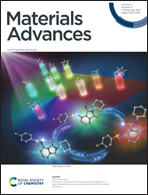MXene quantum dot rivet reinforced Ni–Co LDH for boosting electrochemical activity and cycling stability†
Abstract
The rapid activity degradation of layered double hydroxides (LDHs) is caused by the mismatch of surface component and construction. Herein, MXene quantum dot (MQD) rivets are used to adjust the surface composition and structure of Ni–Co LDH to boost electrochemical activity and stability. The cap of MQD rivets would enrich a large number of unpaired electrons, thereby enhancing the adsorption of electrolyte ions. The surface functional groups of MQDs as rivet shafts can produce a strong interface coupling with LDH to keep stability. The coupling effect should also promote the charge transfer between LDH and MQDs and activate LDH surface adsorption. The effect can be described using the electron location function mapping, charge distribution and X-ray photoelectron spectroscopy. Ni–Co LDH@MQDs exhibits high energy storage activity (87 mA h g−1 at 1 A g−1) and durable stability (98.6% retention after 10 000 cycles) in a two-electrode device. This work opens up a new path for the realization of high-efficiency and long-term stable electrochemically active materials through the interface coupling between MQDs and LDH.

- This article is part of the themed collection: Popular Advances


 Please wait while we load your content...
Please wait while we load your content...